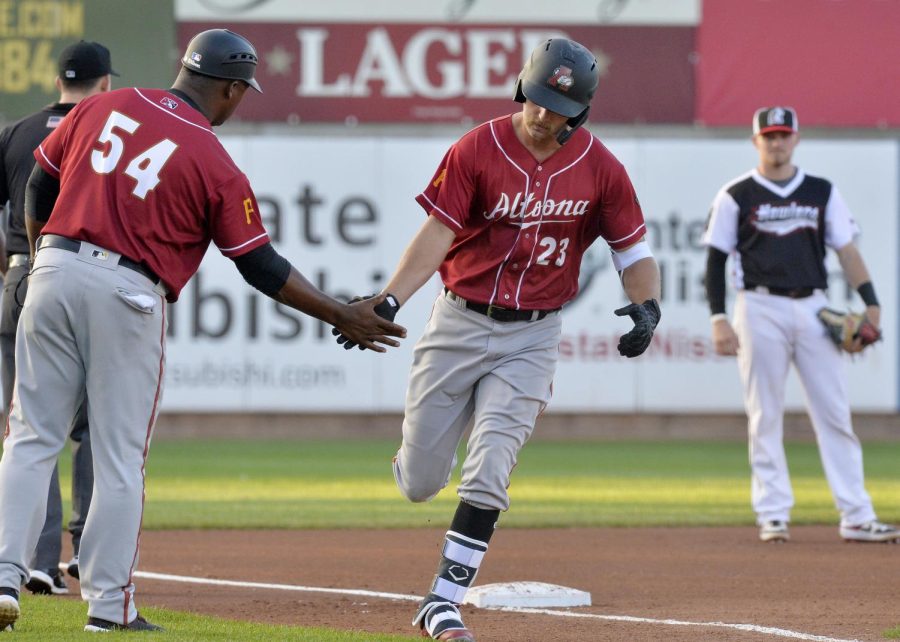Opinion | Minor League Baseball hits homerun for workers’ rights with new union representation
Greg Wohlford/Erie Times-News via AP
Altoona Curve coach Salvador Paniagua, left, congratulates Logan Hill on his fourth-inning home run against the Erie SeaWolves during a Double-A baseball game in Erie, Pa. on July 12, 2019.
September 29, 2022
Players for every minor league team, including fan favorites like the Hartford Yard Goats and Lansing Lugnuts, unfortunately don’t live the lavish pro athlete lifestyle romanticized on TV. In reality, minor league baseball players are some of the most exploited and underpaid workers in the country.
That may soon change thanks to a landmark victory for organized labor.
Minor leaguers officially joined the Major League Baseball Players Association, also known as the MLBPA, on Sept. 14, after decades of fruitless organizing efforts. This recent success is thanks to the tireless efforts of groups like Advocates for Minor Leaguers and veteran minor league players such as Trevor Hildenberger and Joe Hudson. Hildenberger and Hudson spent the summer sharing stories of cockroach-infested apartments and sleeping on air mattresses with fellow players, advocates and lawyers. The MLBPA capitalized on the reinvigorated union talks and sent union authorization cards to about 5,500 minor leaguers in late August. The rest, as they say, is history.
This news is significant for workers’ rights and for the entertainment of the sport. Not only will union representation improve the daily lives of minor leaguers, but it will send an important signal to Major League Baseball owners that players will no longer tolerate the misuse and under-appreciation of their labor. In doing so, the union marks a key victory for the surging organized labor movement that has already reached the highest level of public support in decades.
But let’s pause the champagne popping for just a minute. As important as it is that minor league players have representation, it’s imperative to know why Minor League Baseball needed a union so urgently.
Let’s first talk dollars and cents. The average MLB player salary for 2022 clocks in at about $4.4 million per year. Their compatriots in the minors make anywhere from $5,000 to about $15,000 per season. Minor league teams only pay players during the five or six month season at rates below the federal minimum wage. This is legal because of the Save America’s Pastime Act of 2018, which exempts minor league players from standard minimum wage laws and overtime pay.
In fairness, MLB announced a pay raise to minor leaguers in 2021. Players at the lowest level now make at least $500 per week instead of $290, with the highest level players earning at least $700 weekly instead of $500. This pitifully low wage remains under the federal minimum wage for full-time workers. Ideally, with union representation, minor leaguers can press the owners until they get a wage that surpasses that of a bathroom attendant.
Then there is the matter of housing. Players have long paid for their own housing expenses. This often led to players living in decrepit hotels, team clubhouses, sharing small apartment rooms with multiple teammates on air mattresses and even living in their cars. Much needed change came this year with a new mandate forcing MLB teams to cover housing costs for 90% of minor leaguers in each of their farm systems.
Better living conditions, better nutrition and better offseason training due to guarantees and protections in the future collective bargaining agreement will likely lead to improved athletic performance. Improved performance translates to more ticket sales which translates to more revenue for the owners in the long run. Therefore, this unionization effort has the potential to become a net positive for each party involved — a rarity in sport.
The argument that MiLB and MLB teams cannot afford to pay higher salaries to players is unfounded. MLB as a whole is worth nearly $10 billion. Nearly all MLB team owners are billionaires. It’s not like there isn’t enough money to pay minor leaguers a minimum wage at the very least. Players should earn more than that, of course, seeing as their play generates those billions of dollars for the owners. But hey, you gotta start somewhere.
One could argue that minor league players end up making millions in the majors anyway, so why does it matter how little they make on their way up?
The reality is that only 10% of minor leaguers make it to the major leagues, meaning the other 90% must eventually find another place of work. Around 20% of players enter the minors with only a high school diploma and an estimated 30% are foreign-born. Thus, many athletes may not have the requisite language or trade skills to make an honest living elsewhere.
The next step for minor leaguers is to negotiate a CBA via their MLBPA representation. This will be a tall order. It’s simply not in the nature of billionaire team owners to pay their sources of labor a fair salary. CBA disputes between the MLBPA and league owners led to a lockout that delayed the start of the MLB season this year. We can anticipate a similarly contentious CBA process for the minor leagues.
With the shift in public opinion on organized labor and more awareness of the maltreatment of MiLB players, there is finally hope for a brighter future. It’s been a long time coming, but it’s certainly better late than never.
Grant Van Robays writes primarily about international affairs, social issues and basic human rights. Write to him at [email protected].



